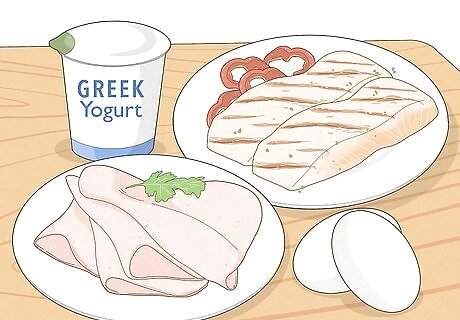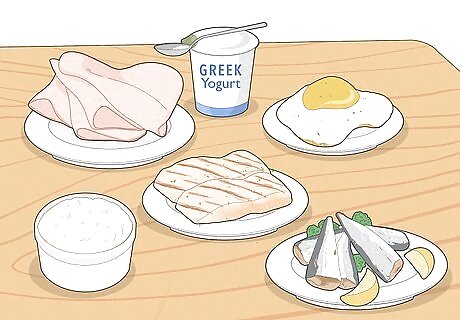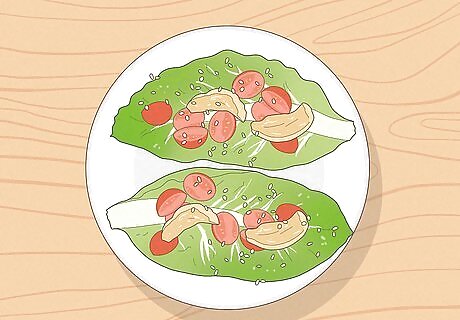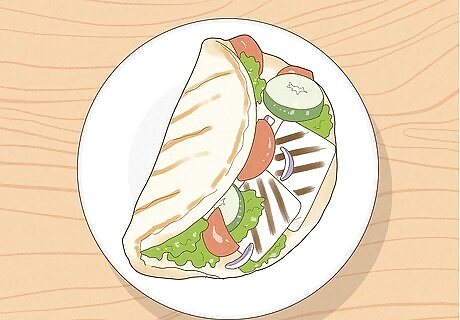
views
- Include high-quality sources of protein in each meal, like skim milk, cottage cheese, lean meats like fish or poultry, or beans.
- Plan out your meals every week and track your macronutrients using an app to keep track of how much protein you’re consuming each week.
- Snack on nuts, seeds, peanut butter, greek yogurt, or cottage cheese throughout the day to help meet your protein intake goal.
Incorporating Protein into Your Meals

Add high-quality sources of protein to your diet. Good sources of high-quality protein can include fish, poultry, dairy products like skim milk or cottage cheese, beans, nuts and seeds, and tofu and other soy products. Try to include some of these protein-rich foods into your diet: Animal-derived proteins: 3 oz canned tuna (20 g of protein), 3 oz cooked salmon (19g), 3 oz skirt steak (25 g), 3 oz cooked chicken breast (27 g), 4 slices of deli meat (8 g), 156 g plain Greek yogurt (16 g), 220 g cottage cheese (24 g), 245g 2% milk (8 g), or 1 whole egg (6g). Registered dietician Jalpa Sheth says that “canned sardines can be a great quick way to add some protein into your diet.” Plant-based proteins: 100 g cooked beans (25 g), 140 g cooked pasta (12 g), 100 g quinoa (12 g), 100 g of nuts (15 g), or 1 scoop of soy-based protein powder (25 g).

Split your daily protein intake over five meals. According to personal trainer Monica Morris, you should aim to split your daily protein intake over five meals—protein-rich meals include “20 to 25 grams on average,” so in order to get to over 100 grams of protein in a day, “it has to be over the course of five or six meals.” Divide how much protein you’d like to eat a day by the number of meals you’ll have, including snacks. For example, if you’d like to consume 150 g of protein per day and you prefer eating 3 meals a day, aim for about 50 g of protein per meal, or 37.5 g if you’re planning on snacking in between. If you’d like to consume 150 g of protein a day and you prefer eating 6 meals a day, aim for about 25 g of protein per meal.

Plan meals in advance for the week. On the weekend or at the beginning of each week, write down all your meals for each day along with the ingredients you need and how much protein each meal will give you. Planning your meals in advance can help you consistently reach your protein intake goal every week. Try to cook at home the majority of the time so you can calculate exactly how much protein you’re putting into your body each meal.

Use an app to track your protein intake and macronutrients. Tracking your macronutrients, like protein, carbohydrates, and fat, can help you make smarter food choices and keep track of your protein intake. Try using an app like Nutritionix or MyFitnessPal to help you track how much protein you’re eating each day. Consider snacking on nuts, seeds, and protein shakes to help you meet your protein goal each day.
Sample Meal Plans

Breakfast Aim to eat at least 37.5 g of protein for breakfast (or 50 g if you don’t plan on snacking throughout the day). Eggs, yogurt, cottage cheese, chia seeds, oats, and peanut butter are examples of high-protein breakfast food items you can add into your meal rotation. Animal-derived breakfast: Make scrambled eggs with cottage cheese, basil, tomato, and spinach for a supercharged breakfast. Include sausage or bacon for a dash of extra protein. Vegan breakfast: Try making overnight oats with chia seeds, oats, a scoop of protein powder, and some peanut butter to boost your energy before you start your day. Vegetarian breakfast: Cook an omelet with eggs, spinach, onion, garlic, and low-fat feta cheese for a delicious and nutritious protein-packed meal.

Lunch Try to eat 37.5 g of protein at lunchtime (or 50 g without snacks in between). Lentils, beans, quinoa, tofu, or lean meats like beef or fish can help increase your protein intake during lunch. Animal-derived lunch: Try making a tuna lettuce wrap with fresh tuna filets, capers, lettuce, and cherry tomatoes for a low-carb high-protein lunch. Vegan lunch: Make a delicious vegan taco bowl using onion, jalapeno, garlic, frozen corn, rice, black beans, avocados, black olives, cherry tomatoes, and either seitan, crumbled tofu, or cooked beans or lentils. Vegetarian lunch: Eat a lentil and bean salad packed with protein and made with red lentils, kidney beans, bell peppers, and spring onions. If you’re on a soft diet, dietician and nutritionist Kelly Gomez recommends soft, rich protein foods like “tofu, quinoa, rice, beans, peanut butter, and almond butter.”

Dinner Eat at least 37.5 g of protein for dinner (or 50 g if you’re skipping snacks) by filling your plate with lean meats, beans, quinoa, nuts, or tofu. Animal-derived dinner: Eat spicy cajun chicken quinoa, made with skinless chicken breasts, quinoa, dried apricots, lentils, red onions, and spring onions for a healthy protein-packed dinner option. Vegan dinner: Try a veggie-packed vegan chili made with sweet potato, onion, mixed beans, and chopped tomatoes. You can also serve it with regular or cauliflower rice. Vegetarian dinner: Make refreshing homemade pesto vegetable gyros with pine nuts, zucchini or summer squash, sweet red peppers, Halloumi cheese, red onion, lettuce, and flatbread.

Snacks If you’re planning on breaking up your protein intake throughout the day, aim to get 37.5 g from snacks like dried meats, nuts, yogurts, and peanut butter. Animal-derived snacks: Try eating 220 g of cottage cheese with berries or chopped herbs for a quick energy boost. You can also eat dried turkey sticks or try a turkey and Swiss cheese roll-up. Vegan snack: Make Greek yogurt bark by spreading a layer on a tray and sticking it in the freezer overnight for a creamy treat. Add berries to your tray for an extra pop of flavor. Vegetarian snacks: Eat roasted edamame, chia pudding, peanut butter celery sticks, or make a delicious protein shake.
How much protein do you need?

Aim to eat 0.36g of protein per pound of body weight. The recommended daily allowance to meet your basic nutritional requirements is about 0.36 g of protein per pound of body weight (or 0.8 g per kilogram). However, the amount of protein you need may increase depending on your age, height, weight, sex, or physical activity level. According to dietician Jalpa Sheth, “different phases of life have different demands of protein.” For example, a doctor might recommend consuming 71 g of protein or more a day if you’re pregnant. Meanwhile, older adults may need to consume 0.45 g of protein per pound (1 to 1.2 g per kilogram) of body weight to meet their daily goal. Consult a doctor to learn what your specific protein needs are. You can also try using this daily nutrient calculator to figure out how much protein you should try to eat each day.















Comments
0 comment